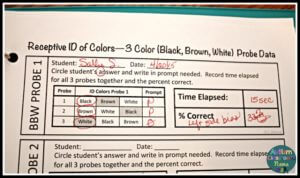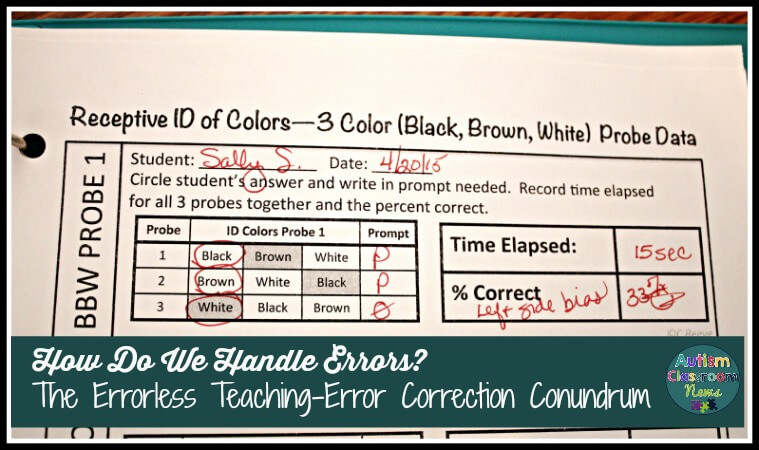Sharing is caring!
At a school where I used to work, we used to have long and academic discussions about minuscule parts of behavioral procedures. To assure consistency across the staff, we had set procedures for how discrete trials were done (among other strategies) and they soon became rules that were expected to be followed. Now, this is great for uniform application across the school. It’s not so great for making little adjustments to suit the needs of individual students. That’s not to say we didn’t individualize–not at all, we did lots of individualization. However, every time we wanted to change from the standard procedure, we ended up having to convince someone on the team that it was OK to do something different (see it’s not only the individuals with autism who can be rigid) :). One of the debates that we would often have about changing was on how to handle errors in discrete trials. So today I want to share some of the things I’ve learned and what research tells us to help you make decisions about what strategy suits your learner.
Generally, I would say my default position is to use errorless learning. Errorless (or near-errorless) learning is when you use prompts proactively to avoid the student giving you the wrong answer. To do this we might set up materials to prevent errors, like using stimulus prompting and fading to help the student give the correct answer the first time. We might use positional prompts by putting the right answer closer to the student (although see the drawbacks of doing this in some instruction here). The key is to set up your instruction from the start so that the student is likely to get the right answer. Getting the right answer allows him to access the reinforcer and, if the reinforcer is really reinforcing the behavior, the correct answer to that particular instruction should increase–in other words, the child learns.
There are many ways to implement errorless learning. This is simply a brief overview of them and if you aren’t familiar with using them, this won’t replace working with someone who can coach you through it.
One type of errorless teaching is to do probes prior to each set of trials in which you wait for the student to complete the task independently and use least to most prompting to see what level of prompting was needed today. Then when you present the learning trial (different than the probe), you immediately prompt with that prompt or you immediately prompt with the next least intrusive prompt. So, let’s say you did a probe with Sally identifying the color green from an array of 3 and she got it right when you gave her a partial physical prompt–that is you took her hand and pointed it in the right direction of the green card but she completed the motion. Then, during the teaching trial you would present the cards, say, “green” and immediately give her that same prompt–or give her the next prompt up the hierarchy, which would be gesturing to the right answer. Then you would reinforce any trials in which Sally didn’t need a more intrusive prompt than she needed during the probe.
 My discrete trial kits are set up so that this system is easy to use with probe trials set up for each set of materials. You would do 3 probe trials in which you don’t correct the errors and provide least-to-most prompting to see what level of prompting is needed. Then you do your 9 trials with that level of prompting. This means every day you are giving the opportunity for the student to be more independent and then use that as your baseline for the rest of the learning trials. This way you don’t do many trials in which the student makes multiple errors and then learns them as part of the skill. Using the sets of 3 stimuli for each set of trials, there are 3 probe trials so that you can determine if there is a bias for the materials. You can read more about this method here.
My discrete trial kits are set up so that this system is easy to use with probe trials set up for each set of materials. You would do 3 probe trials in which you don’t correct the errors and provide least-to-most prompting to see what level of prompting is needed. Then you do your 9 trials with that level of prompting. This means every day you are giving the opportunity for the student to be more independent and then use that as your baseline for the rest of the learning trials. This way you don’t do many trials in which the student makes multiple errors and then learns them as part of the skill. Using the sets of 3 stimuli for each set of trials, there are 3 probe trials so that you can determine if there is a bias for the materials. You can read more about this method here.
Another way that errorless learning is often used is to intervene with prompts when you see that a child is going to get the answer wrong. This might work if you catch it very early in the chain of behavior. However, you run a great risk of building the error into the learning. By this I mean the student who went to touch his head instead of his nose and you stopped him midway and let him complete the action who then always starts to touch his head and then his nose when you say, “touch your nose.”
And another way is to use it as it is used in this video in which you use prompts and then systematically fade them as the student becomes more familiar with the task. This video (which is not from me but available on YouTube) also demonstrates mixing up trials so that students get more correct responses and are successful.
Now, the flip side of errorless teaching is error correction. In error correction, you let the student make an error and tell him no and represent the trial. The original Lovaas’ study used what they called the “no-no-prompt.” This meant the student could answer wrong twice and then the third trial was prompted. Since that time, we generally try not to have the student make a mistake for more than 1 trial. Error correction is more like what we are used to doing in our “real life” where people make mistakes.
So which one should you use?
This is really another situation in which it depends on the student to some degree. Here are some pros and cons of each.
Pros for Errorless Learning / Teaching
- Students are successful and instruction is fun
- Students come into contact with the reinforcer more frequently
- Students avoid building errors into their learning–you avoid the student who touches his head before his nose when the direction is to touch his nose
- Engagement is high because students are successful
Potential Drawbacks of Errorless Learning / Teaching
- If not done well, students can become dependent upon the prompts. They learn to wait for the prompt the prompt always comes.
- Sometimes, again if not used accurately, students build the prompt into their learning. For instance a student who sticks out his hand but doesn’t complete the action because he’s waiting for the prompt.
- Learning can take a very long time for some students using errorless teaching because it takes a long time to successfully fade out the prompts.
Pros for Error Correction
- Although this isn’t something we should base our decisions on, it comes more naturally to people and instructors. Consequently we have to expect it will be something students come in contact with frequently in their daily life.
- For some students, this is efficient because they learn from their errors. They make a mistake once, get prompted and shown the right answer a couple of times and then are able to give the correct response. This is why this is a typical strategy used in teaching.
- There is some research that it is more efficient than errorless teaching (Leaf, Sheldon, & Sherman, 2010).
Potential Drawbacks for Error Correction
- Many of our students don’t learn much from mistakes. Mistakes require us to problem solve what we did wrong. Many of our learners learn it was wrong, but they can’t determine what they should do next.
- Many of our students don’t respond well to being corrected which may create some behavioral issues.
- Some students build the errors into their learning and have to be retaught.
So, which should you use? Try both of them, take data on the student’s performance and decide which works best. There is vast individual differences in the learning of our students and we have to make our decisions based on their performance. If you have a student who is likely to exhibit significant challenging behaviors or has difficulty being motivated to stay in instruction, then errorless learning might be the best to start with. If you have a student who can sit, attend and learn without challenging behavior and is likely to become dependent on prompts when they are provided, then an error correction procedure might make the most sense.
So which way of handling errors are you most familiar with and do you prefer? I would love to hear about it in the comments!
Many of you noted in the readers’ survey that you would like to have some of the posts like this in handout form to share with teachers, staff, etc. So here is a pdf of the pros/cons of the different procedures. Click Determining How We Handle Errors handout to download it. And if you’d like more information on the research, just leave me a comment and I’ll point you in that direction.






